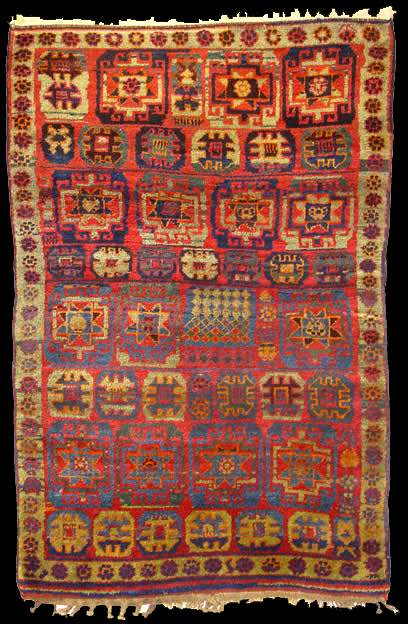|
Antique
Zakatala rug with memling guls, North Azerbaijan, 19th century.
Rippon Boswell & Co. International Auctioneers
of Rare Carpets & Textiles: Antike, seltene und dekorative Teppiche,
Flachgewebe und Textilien
AUCTION DATE: Sunday 12 November 2006
LOCATION: Hotel Baur au Lac, Zürich
|
|
Memlinc-Guls, Sterne und diverse Kreuzformen von unterschiedlicher Grösse
und Form erstrecken sich über ein schattiertes hellrotes Feld rund um einen
nicht-zentrierten Abschnitt mit einem Halsketten-Motiv, das von einer
einzelnen, halbmatt-blauen Bordüre mit vielfarbigen Blumenköpfen eingerahmt
wird. Das dichte, gehaltvolle Gewebe, zahlreiche Abschnitte mit Abrash,
geflochtenen Fransen und der primitive Zeichenstil sind typisch für die
seltene Herkunft aus Zakatale, das sich in der weitläufigen georgischen
Provinz nördlich von Erivan befindet. Diese wertvollen Sammlerstücke
entstammen im Gegensatz zu anderen kaukasischen Weberzeugnissen einer
vollkommen anderen Tradition und können daher vielmehr in enge Beziehung zu
den dicken Yatac-Bett-Teppichen der anatolischen Nomaden bzw. den
Gabbeh-Teppichen aus Südpersien gesetzt werden.
Memlinc-guls, stars
and various cruciforms of irregular size and construction are deployed over
a shaded light red field around an off-centre compartment containing a
necklace motif, framed within a single eggshell blue border of
multi-coloured flowerheads. The dense, meaty weave, numerous areas of
abrash, braided fringes and primitive drawing style are typical of the
scarce Zakatale origin, in the broad Georgia region to the north of Erivan.
Representing an entirely different heritage to other Caucasian weavings,
these highly collectable items are most closely related to the thick yatak
bed carpets of the Anatolian nomads, or to the gabbeh rugs of southern
Persia.
 |

